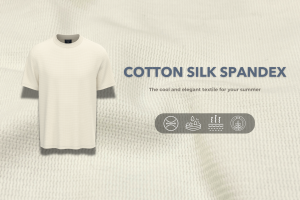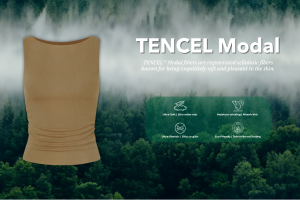Linen Fabric - The Trend of Organic Fashion Fabric
Sustainable fashion textile is currently a popular topic in the fashion industry, favored by designers. Consumers not only care about the style of clothing but also have high demands for the textiles, prioritizing natural fiber to minimize the negative impact on the environment. Linen fabric is a variety that has been around for a while yet is always in style. Let’s explore the linen fabric with Tbond in the article below.

1. About Linen Fabric
Linen, also known as flax fabric, is produced entirely from the natural fibers of the flax plant, which originates from Switzerland, and its fibers are separated and woven into fabric. Linen is an airy material made from the fibers of the flax plant. The uniqueness of linen lies in its natural texture, inherent durability, and coolness in hot weather, characteristics that have long been appreciated by the fashion-conscious.

Linen is a sustainable fabric made from flax fibers. Flax plants are cultivated in most countries around the world and have been used for fiber for over 6,000 years. To extract the fibers, the plant is either cut or hand-pulled from the ground. The seeds are then removed through a process called winnowing or seed separation. Next is the extraction and removal of the plant’s root from the fibers. Once the fibers are separated to collect the longest pieces, which can be up to nearly 8 inches long, they are combed into threads and ultimately woven into fabric
2. The Features of Linen Fabric
Because linen is porous, it naturally absorbs moisture and heat-wicking, which makes it a great heat conductor and a favorite for summer apparel and bedding. This fabric is available in an array of textiles, and the natural fibers last color better than some other fabrics. Because linen fabric naturally resists bacteria, it is a popular option for window decorations and everyday accessories such as high-functionality pillows in daily life.

3. Linen Fabric: An Environmentally-friendly Fabric
In the fashion industry, sustainability is currently seen as one of the most important future trends. While certain well-known companies, such as VivaTerra, Coyuchi, and Citizenry, concentrate on organic cultivation and production, linen fabric is naturally sustainable thanks to its ethical and ecological aspects.
“Flax plants use less water and fewer pesticides in the cultivation process than cotton which makes it more sustainable,” – Anna Heyd stated
Linen fabric is listed among the safest and most environmentally friendly materials. A fabric is considered environmentally friendly when it meets criteria such as being made from natural materials, easily decomposable, or recyclable.
As mentioned by Tbond earlier, linen is a fabric woven from the fibers of the flax plant, a completely natural material that does not involve the use of any harmful chemicals in the weaving process. The entire process of planting and harvesting flax fibers also has no adverse environmental impact. Flax plants exhibit robust growth without the need for chemicals or pesticides during production. Instead of retting in alkali or oxalic acid, producers immerse the flax plants in water to remove impurities and soften the linen fibers. Moreover, flax has the ability to thrive and grow in nutrient-poor soil and requires less water for cultivation compared to cotton.

Although flax plants don’t require a significant amount of fertilizer and pesticides for cultivation, it doesn’t mean that they are not used at all. Most flax seeds are grown with nitrate, and excess nitrate can leach into water sources, potentially harming the surrounding environment.
Unlike synthetic fabrics, linen fabric has the ability to undergo biological decomposition, meaning its components can be absorbed by the environment in just a few years. For fibers like polyester and nylon, it can take hundreds of years to fully decompose. However, linen fabric has a high recyclability rate, making it suitable for long-lasting use in various daily life applications.
Thanks to these characteristics, linen is referred to as an organic material and is encouraged for use in sustainable fashion. The current production technology for linen fabric utilizes microbiological processes to harvest soft fibers and rapidly decompose the outer shell layer. This efficient fiber separation doesn’t require chemicals and helps maintain a microbial ecosystem.
4. The Application of Linen Fabric in Fashion
In the fashion industry, linen fabric is used for various applications, creating summer dresses, modernized Ao Dai, featuring lightweight surfaces, or breathable suits. Additionally, when blended with natural materials like cotton, linen can be tailored into elegant vests or sophisticated shirts. The truly captivating aspect of this fabric lies in its combination of durability and luxury, allowing for diverse interpretations in any artistic creation.

Ways to care your Linen Fabric:
- Wash Below 40°C: Wash the fabric in water below 40°C, either in warm or cold water, to avoid altering the shape and color of the fabric.
- Use Low Concentration Detergent: Opt for a detergent with a low concentration of cleaning agents to preserve the durability of the fabric and ensure long-lasting preservation.
- Air Dry Naturally: After washing, let the fabric air-dry naturally instead of using a dryer. This helps maintain the fabric’s durability and color.
The information above is the most detailed guide about Linen fabric in sustainable fashion. We hope that you will gain more knowledge about this fabric and its applications in your life.
>>> Xem thêm:
Sorry, we couldn't find any posts. Please try a different search.
MANUFACTURING PROCESS





FREQUENTLY ASKED QUESTIONS
The required MOQ to place an ODM
The quantity of sample production at Tbond will be flexible depending on the partner's needs. However, the necessary MOQ for each order is 300 pcs/sample to achieve optimal cost and quality during the sample production process conducted by Tbond.
Do we have the manufacturing factory?
At present, Tbond owns a system of manufacturing plants in the downtown area and in the western provinces. Additionally, we are also partners with major domestic manufacturing plants with abundant and stable labor resources, totaling thousands of workers.
How many workers are there at Tbond?
Tbond possesses a team of experienced professionals in the fashion industry with departments including Brand R&D, market research team, production planning department, customer care department along with a skilled workforce of thousands of workers.
















